- 10 of the Best Company Career Site Job Search Examples (2026 Update) - December 17, 2025
- 10 Attractive Job Posting Examples - December 23, 2024
- Top 18 Employer Reviews & Ratings Sites for 2024 - September 20, 2024
This is your complete guide to recruiting microsites.
If you want to:
- Create a more targeted candidate experience
- Drive more organic traffic
- Turn more job seekers into applicants
Then this is the guide for you.
Let’s roll.
Recruiting Microsites Fundamentals
In this section, we’re going to cover the basics of recruiting microsites.
What Are Recruiting Microsites?
Recruiting microsites are a way of attracting candidates and job seekers via targeted landing pages.
So, common recruiting microsite themes are based on:
- Department
- Location
- Initiatives/Programs (Interns, Diversity, etc.)
The #1 thing that makes recruiting microsites unique compared to other pages on your career site is that you can focus solely on one theme/topic.
The Difference Between Traditional Microsites and Recruiting Microsites
Your recruiting microsites don’t need to follow the rules of a traditional microsite.
The concept is more like a landing page.
So, we call them microsites because they are pages based on specific topics.
The big difference between recruiting and traditional microsites is that recruiting microsites don’t distance themselves from the overall corporate/career website experience.
Some common drawbacks of traditional microsites include:
- Design
- Different navigation
- Messaging
- Different domain/URL (read below)
With a recruiting microsite, you won’t get hurt by these drawbacks. So, candidates will know with certainty that the recruiting microsite is associated with your company. They will also easily be able to leave the microsite to find more information on the rest of your website.
In contrast, traditional microsites are usually hosted on an entirely different domain or subdomain. This can create confusion, especially with candidates on high alert for recruiting scams.
So, with a company career site, you’re most likely already hosting on a separate subdomain (i.e. jobs.[company].com or careers.[company].com).
Your recruiting microsite URLs could follow the following format:
- jobs.[company].com/[department]
- jobs.[company].com/[location]
- jobs.[company].com/[initiative]
Benefits of Having Recruiting Microsites on Your Career Site
- Specific content focusing on a single department, location, or initiative
- SEO boost
- Effective landing pages for social media and ad campaigns
- Great for experimenting and testing what content works
Another awesome benefit of microsites is you can create them based on your needs as your company evolves.
Opening a new office? Then, create a microsite for that location.
Need to hire a lot of salespeople? So, create a sales recruiting microsite.
The possibilities are endless.
“We’ve seen clients double their application rates just by tailoring microsite messaging to specific roles or locations,” shares the Co-Founder of Scope Recruiting.
Building Your Recruiting Microsites
In this section, I’m going to show you exactly how to build your recruiting microsite.
These are the same exact microsite building techniques that our clients use to increase the candidate experience on their career site.
Add a Hero/Feature Media
If you’re serious about creating an effective microsite, then, you NEED a feature image or video.
(In other words: engaging media that engages candidates).
So, here’s an example of a Chicago recruiting microsite:
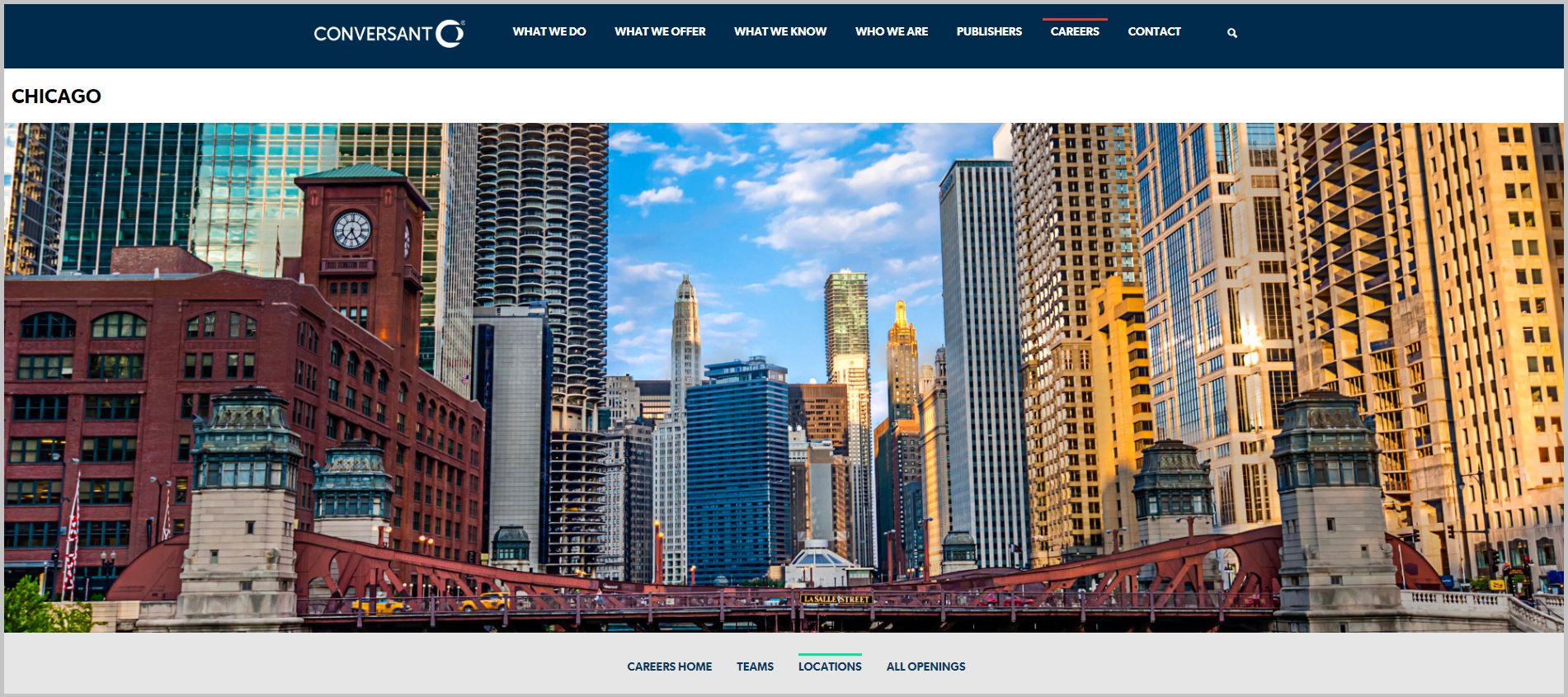
As you can see, this page is focused on Chicago, which is reflected in this beautiful downtown Chicago skyline.
It’s completely focused on the location where Conversant’s Chicago jobs are located.
So, candidates who land on this page are expecting to see content relating to Chicago.
Add a Complete Set of Jobs Based on the Recruiting Microsites Topic
You’ve got 2 options here.
Option 1:
Continuing on the Chicago example above.
You’ll want to add all Chicago job listings like this:
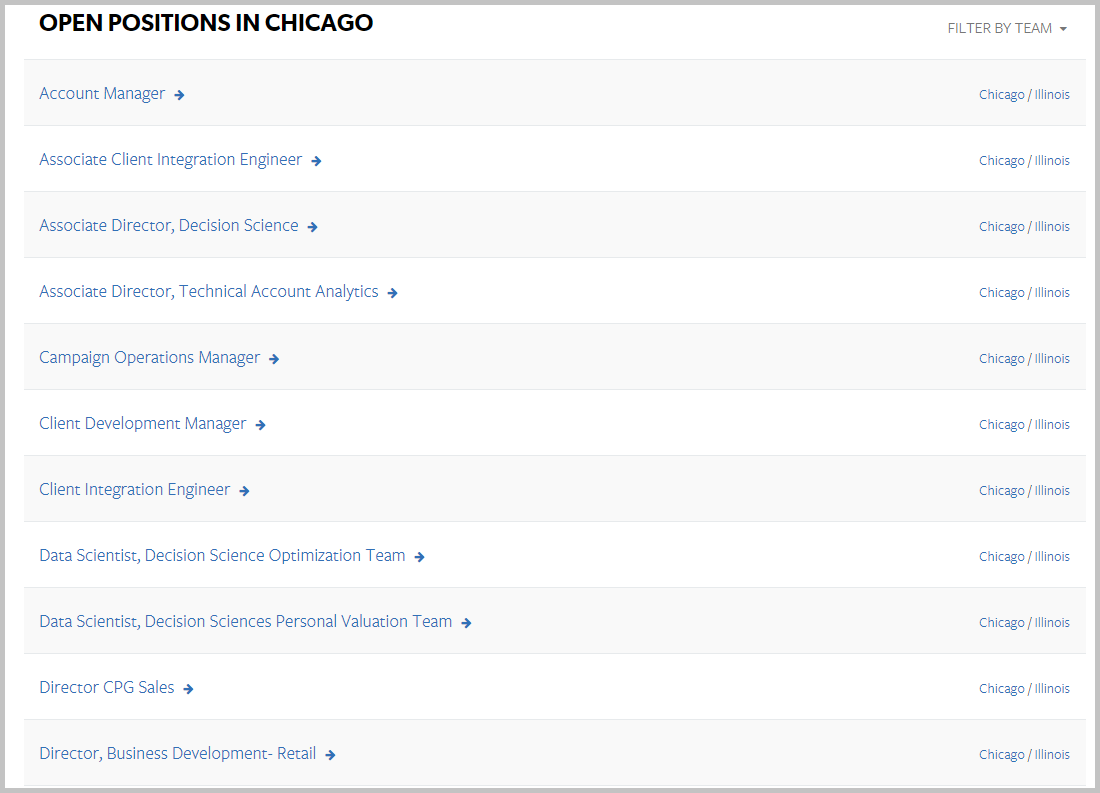
This makes the microsite more complete. It gives the candidates the ability to go directly to any job posting located in Chicago.
Option 2:
Create a button that says “Apply now” or “Find [department/location/program] jobs”.
This button can link to your ATS page that will be pre-filtered with the specific set of jobs. Like this:
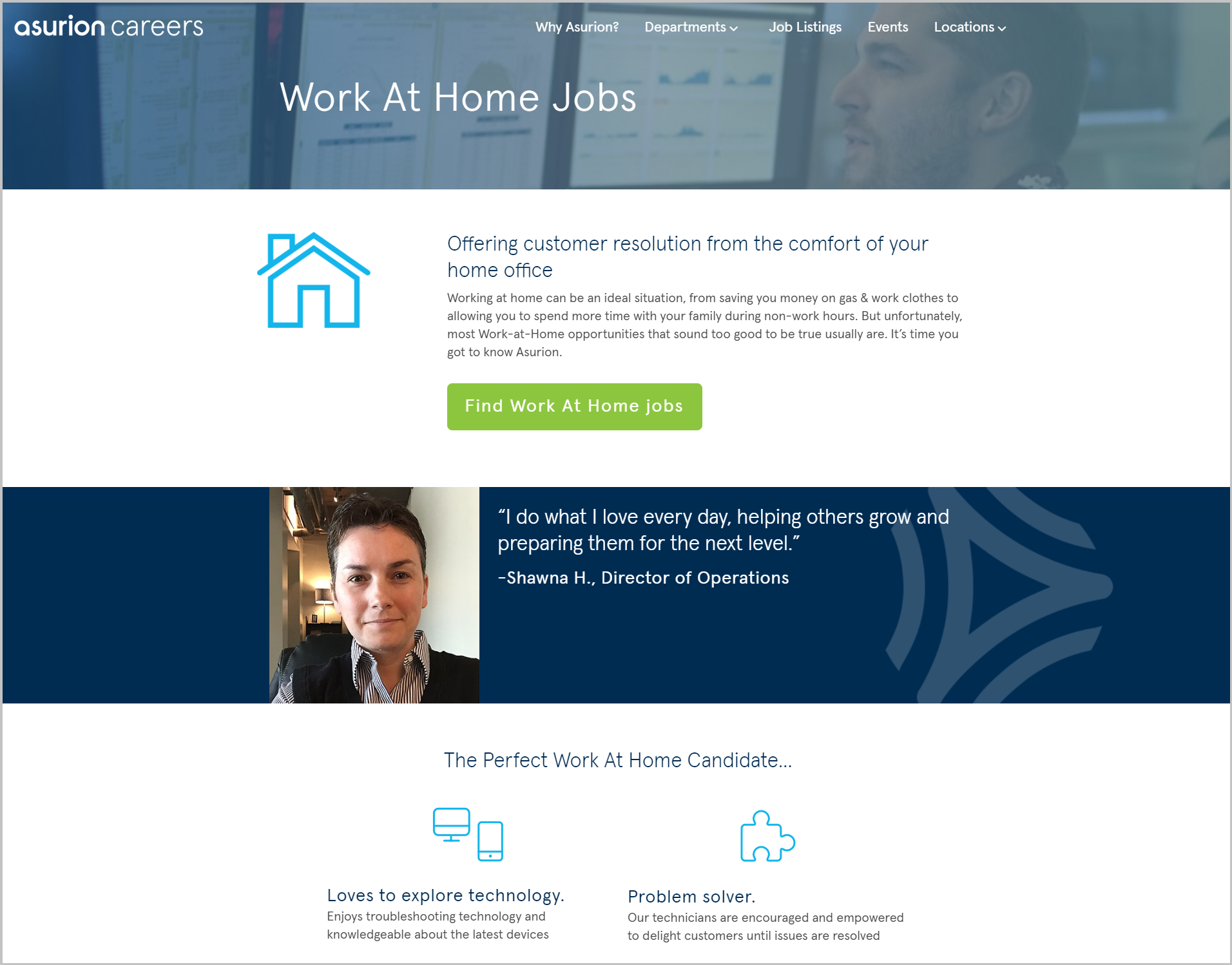
Clicking “find work at home jobs” sends you to a page that displays all work at home jobs.
Like this:
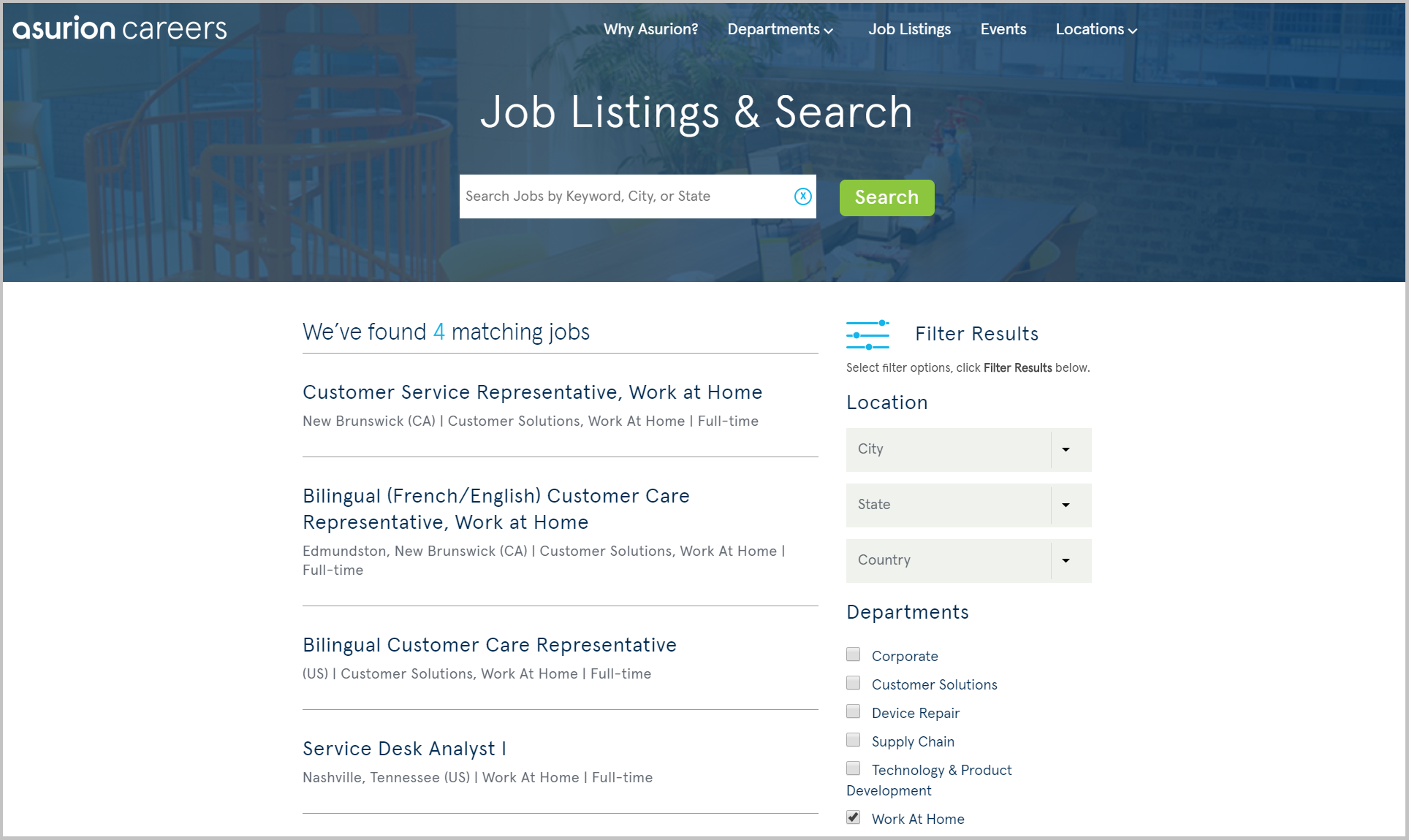
Filter By Team Dropdown
This feature would change based on the focus of your microsite.
Therefore, you might have a ton of jobs related to the microsite.
So you’ll want to add a “filter by team” dropdown. This also gives candidates a way to make the set of jobs smaller and focused.
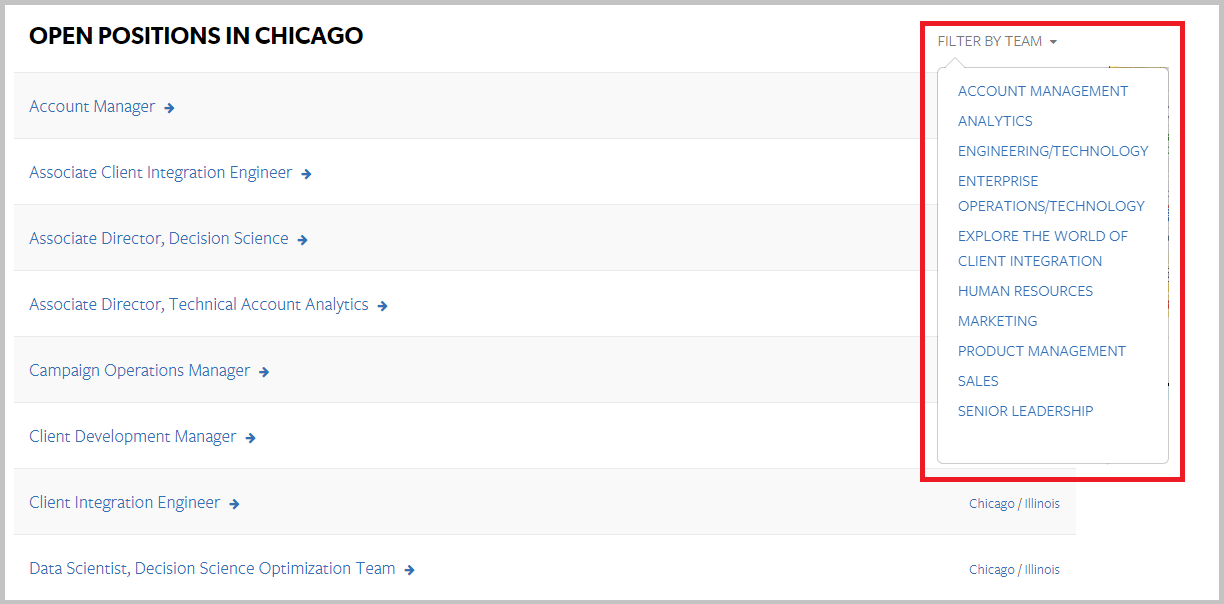
For a department-specific recruiting microsite, you’ll want to add “filter by location”.
You’ll also want to “filter by location” for initiative/program-specific microsites.
Add Widgets
Want more engagement?
Use widgets like these to further articulate the focus of your microsite:
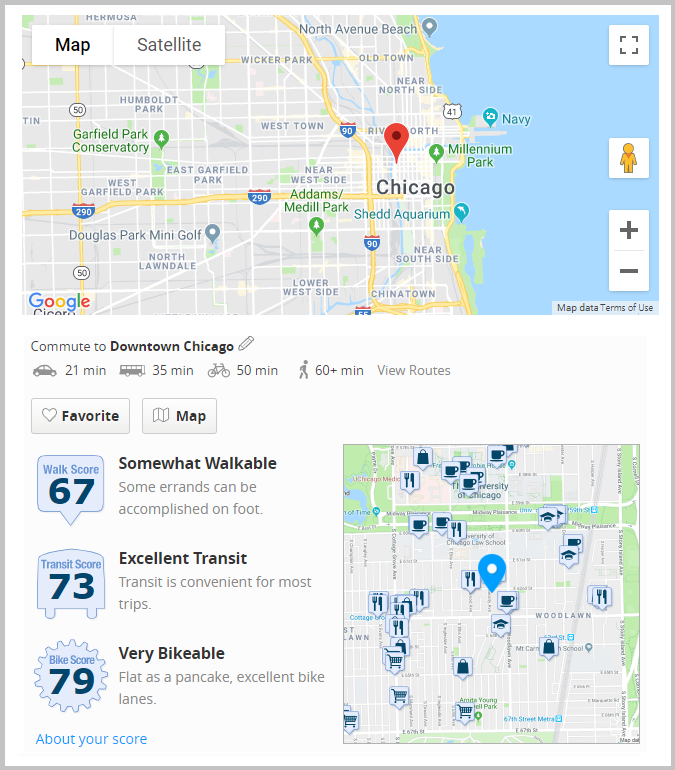
Maps, Walkscore, and other location content are important elements to add if it’s a location-based microsite.
A new recruiting widget is catching our eye from Comparably.
It focuses on company culture, CEO, awards, and employee reviews. It’s also an awesome recruiting widget that can be used on any page of your career site.
So, here’s what it looks like:
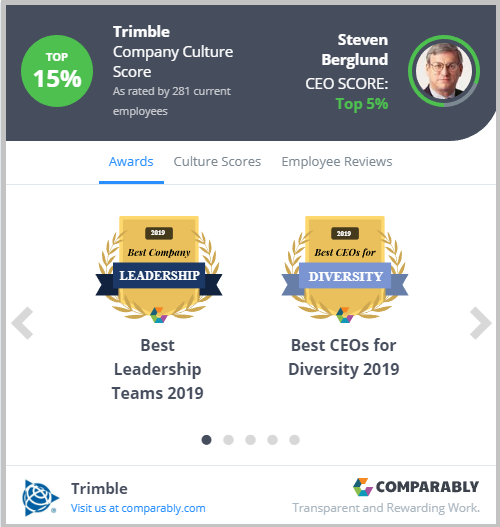
We’ve seen our clients raise their time on page just by incorporating a couple of these.
Additional Elements
FAQ: A great way to optimize for SEO is to add an FAQ at the bottom of the microsite page. So, add some questions that candidates ask you all the time.
Check out the bottom of Hilton’s Work from Home recruiting microsite. They also have an FAQ section focused on Work From Home positions:
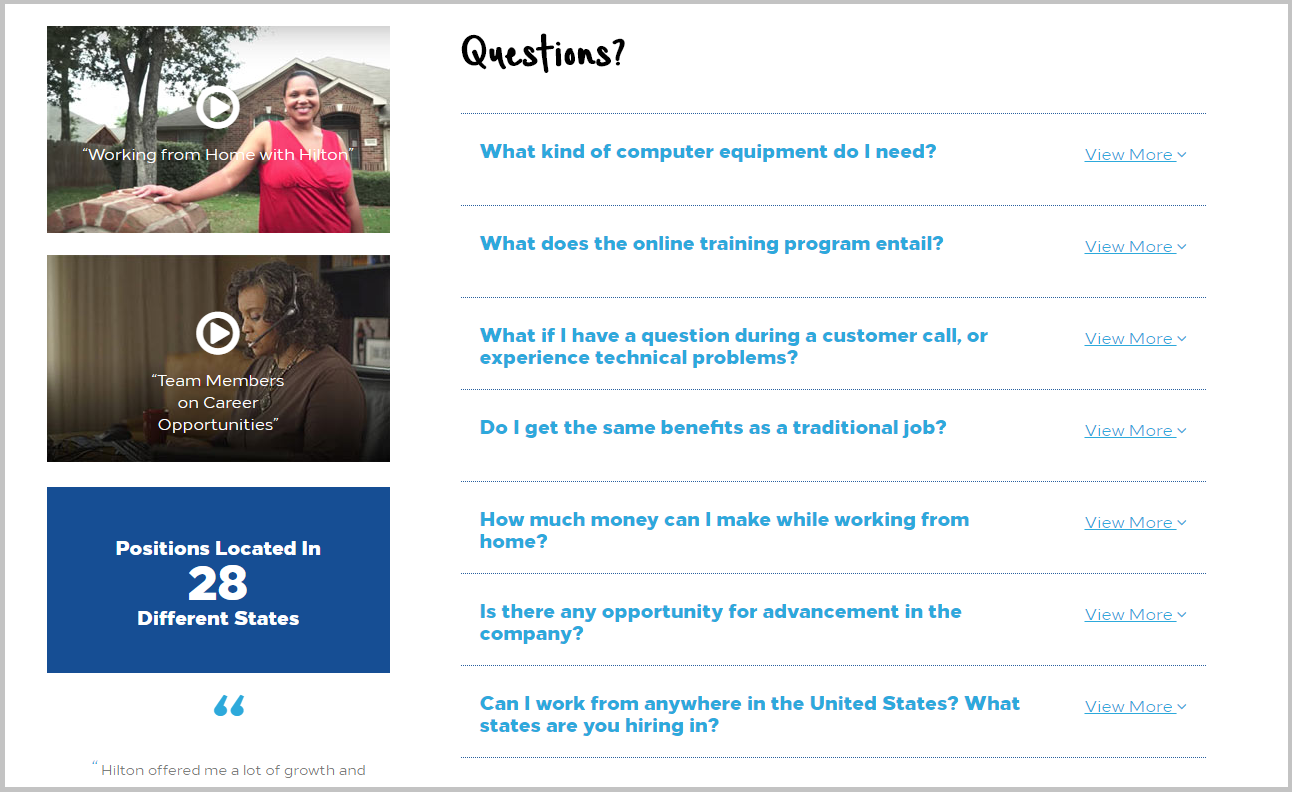
Benefits: One of the most sought after pieces of information for candidates is benefits.
It’s smart to add these not just on microsites, but also your job postings.
Career/Blog Content: Add a list of resources/career content to your recruiting microsite.
You want the content to be relevant to the topic of the microsite. For example, if you offer employees mentorship or professional development opportunities, this is a great place to mention it.
You can also list your best overall posts (i.e. posts with the most pageviews or highest engagement).
Recruiting Microsite Examples
Now it’s time to show you some microsite examples.
So, I’m going to share four specific examples of recruiting microsites.
These examples have great SERP for keywords and are made to attract, engage, and convert candidates.
Work At Home Recruiting Microsite (Working Solutions)
Attractive and engaging.
Notice the:
- Prominent headline
- Polaroid pictures with values
- Great copy (i.e. “Be Your Own Boss”)
- Video’
- Benefits
- Employer of Choice awards for work at home (in the footer)
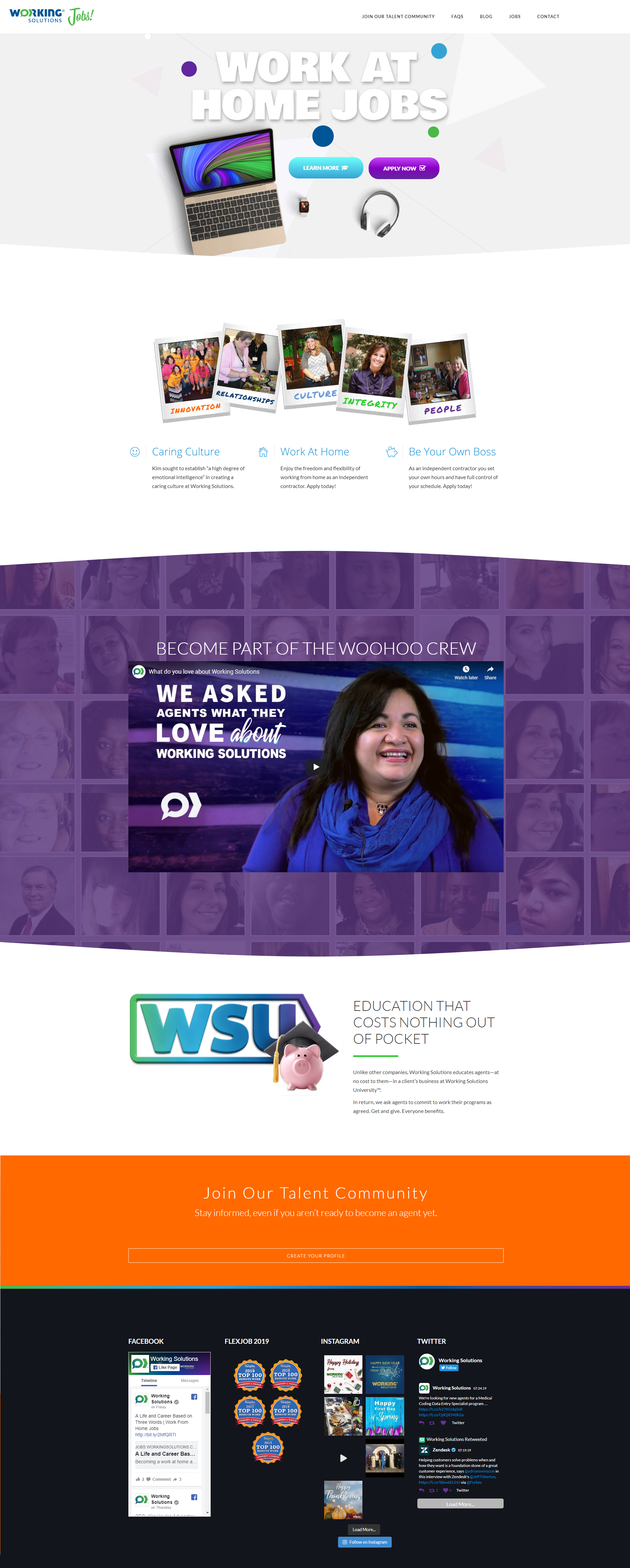
Sales Recruiting Microsite (Spectrum)
Brand-focused.
Notice the:
- Focus on brand colors (blue background, white text).
- Great headline and focus on bonus, pay, and commission
- Day in the life of a Sales Rep video
- Sales-focused copy
- Job perks
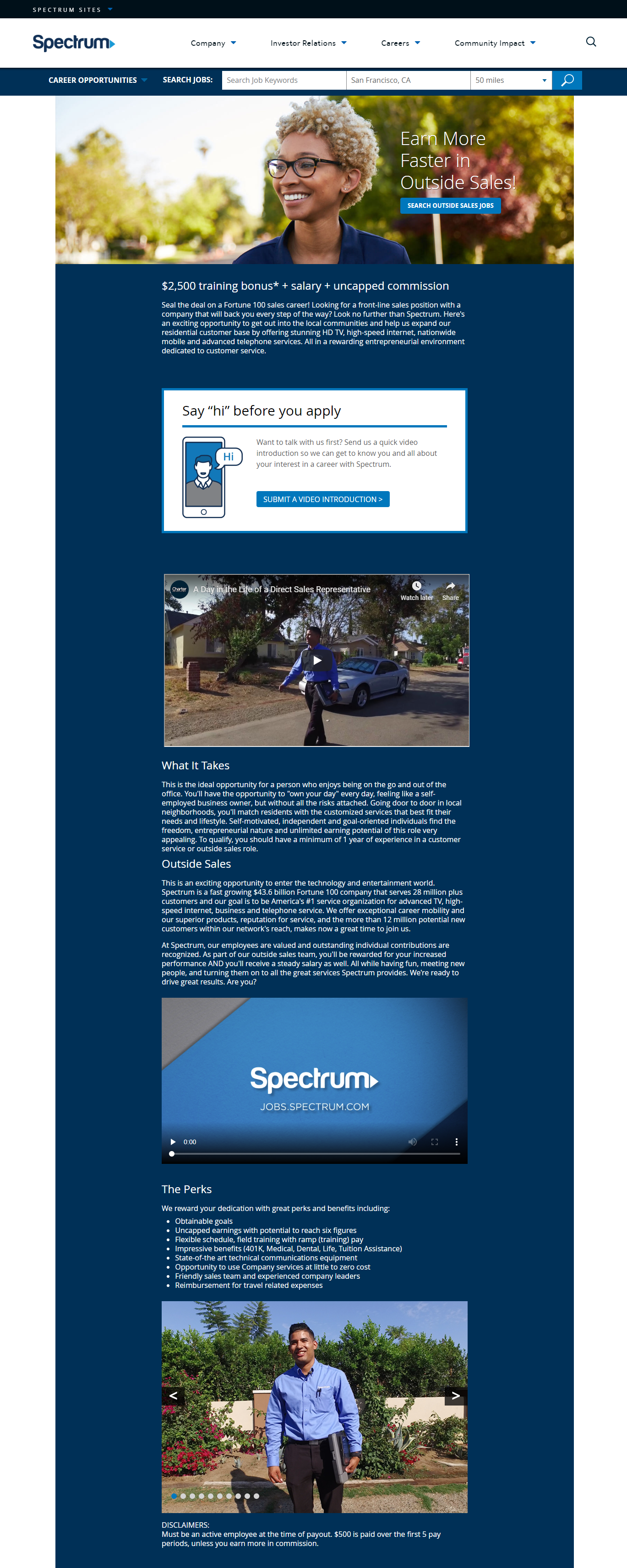
San Francisco Recruiting Microsite (Google)
Simple and effective.
Notice the:
- Feature images of the San Francisco office, Bay Bridge, and employees
- Nice intro copy on San Francisco
- Organization and segmentation of departments with job counts
- Map
- Location-specific blog content
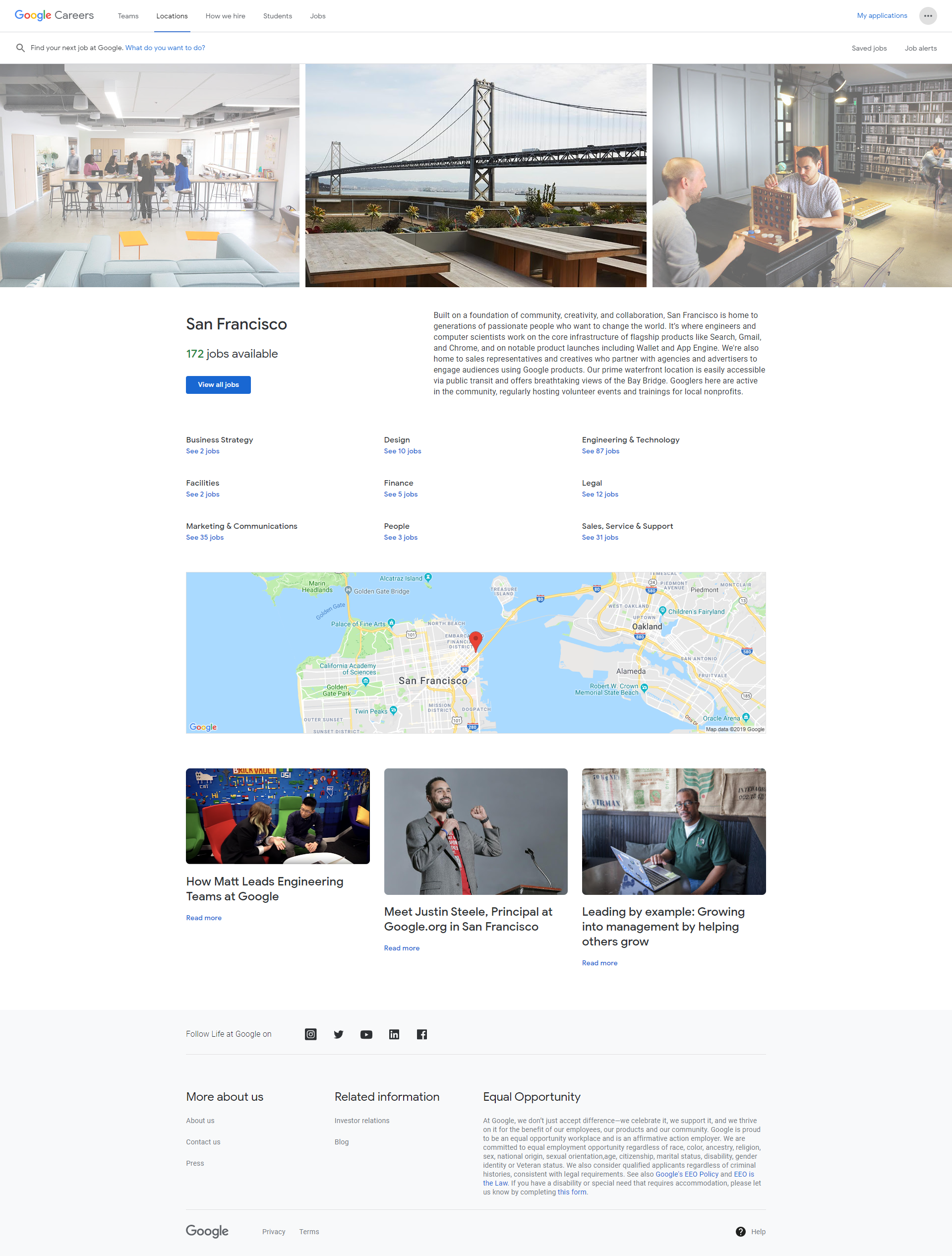
Diversity and Inclusion Recruiting Microsite (Dell)
Detailed and inviting.
Notice the:
- Diverse hero image
- Hashtag (#culturecode) a great way to engage through social media
- Use of numbers (operating countries, global chapters, etc.)
- Focus on multiple groups (Gender, LGBTQ, People with Disabilities)
- Employer of Choice badges for diversity

More Recruiting Microsite Examples
- Cardinal Health Sales Recruiting Microsite
- TTEC Work From Home Recruiting Microsite
- Walmart Engineering Recruiting Microsite
- Cisco Engineering Recruiting Microsite
Use Your Microsites as Landing Pages for Paid Advertising Campaigns
Social Media
Another way to utilize your microsites is to use them for social media recruiting campaigns.
So, if you’re running Facebook recruiting ads for certain positions or locations, follow these steps:
- Create a microsite for a department/location
- Create your facebook recruiting ad
- Select your targeting options (demographics, behaviors, locations, etc.)
- Make the microsite as the click-through URL of the ad
It makes for a very targeted ad experience for candidates.
Google Adwords
Using Google Adwords is an effective way to get your link to the top of Google search results, without having to do all of the SEO work.
Maybe it’s hard to rank organically for the keywords you’re targeting because:
- The keyword is broad (i.e. “San Francisco jobs or Engineering jobs”)
- The competition for the target keyword is steep
- You don’t have enough time for the process of trying to rank on Google
Use Google Adwords to bid for your target keyword to show up near the top.
Also, use the recruiting microsite’s URL as the click-through link.
Job boards
Use your microsites to guide candidates from third party job boards such as LinkedIn or Indeed to your own customized web pages. That way, candidates get personalized information for the microsite vertical you’re trying to recruit for.
So, here’s a sample of how you could use microsites with job boards:
- Create your microsite(s)
- Post the corresponding position(s) on job boards like LinkedIn
- (Optional) Pay to promote your job listing to relevant job seekers
- In your job description, include links to your microsite(s) with the appropriate content. If you mention the importance of diversity and mentorship, consider linking to your DEIB recruiting microsite, for example.
- Use data from your recruiting microsite to inform how you recruit in the future
Paid ads
Google Adwords is just one paid advertising tool for promoting your recruiting microsite. You can also take advantage of targeted advertising opportunities on sites such as YouTube, LinkedIn, and Facebook to reach candidates who have already shown interest in your company. These ads can feature a selection of the content on your recruiting microsite, and then link to them. Customize advertisements and microsites by information such as:
- WFH opportunities
- Candidates in a certain location
- Candidates who have already researched your company or applied to another role
- Folks whose job title matches a position you’re recruiting for
- Second and third degree LinkedIn contacts for people who already work at your organization
Recruiting Microsites vs. Career Pages: Key Differences
When looking for a better option to attract potential candidates, it’s important to understand the difference between recruiting microsites and traditional career pages. Both play a role in the recruitment process. However, they serve different audiences and have distinct functions.
Target Audience Focus
One key difference is how these pages serve their target audience. So, a careers site, which is part of a company’s main website, tends to cater to all visitors. It showcases open positions, company culture, and business partners, but it’s broad. Recruiting microsites, on the other hand, are more focused. They are often built for specific roles, departments, or special programs within a company. So, this makes them a better option for attracting quality candidates for specific needs.
Customization and Flexibility
Another difference lies in how flexible these pages are. So, recruitment microsites allow recruiters to go the extra mile by offering tailored web experiences for their ideal candidates. They also often use elements like full-screen hero images, unique logos, and smart bars to create a targeted, immersive experience. In contrast, a typical careers page may stick to a broader format that supports a wider range of content types. However, they lack the customization that can make impressive recruiting microsites stand out.
Enhanced Marketing Strategies
Recruiting microsites are also a great way to integrate digital marketing and marketing strategies into your hiring efforts. For example, companies can focus on specific departments or roles, using blog sites, industry reports, or even a footer CTA to engage prospective employees. So, by comparison, traditional career pages can feel like a home page—informative but general. Additionally, the detailed forms of content on a recruitment microsite can give potential applicants the chance to explore detailed information about a specific job or department.
Better Content and Conversion Opportunities
A recruitment microsite allows you to include essential elements that are job-specific, like the salary range, work environment, and team details. You can also share case studies, great examples of successful hires, and even daily doses of recruitment marketing updates. So, this level of personalization means candidates aren’t just spending time scrolling through the same careers site that hundreds of others have seen. Instead, they engage with content types designed just for them. Thus, improving the chance of conversion.
In contrast, traditional career pages don’t always have the flexibility to dive deep into specifics like the interview process or search committee details for every job.
Cost-Effectiveness and Time Efficiency
Another benefit of careers microsites is their cost-effective way of attracting top talent. For example, you can reduce hiring process costs by creating a recruitment website or microsite template that targets specific talent pools. Thus, minimizing the only thing needing adjustment – the content. Also, recruiting teams save time, as microsites can serve as a great resource to pre-screen potential applicants before they reach the screening committee.
So, by using recruiting microsites with best practices in place, you can build successful recruiting strategies that create a strong pipeline of quality candidates while speeding up the talent acquisition process. They also offer more flexibility, targeting, and better engagement for new business needs, which traditional career pages sometimes lack.
In Conclusion…
Ongig’s software automatically generates recruiting microsites for you.
So, we make the hard part easy.
Next, all you need to is:
- Create some kick-ass content
- Add a couple of images or a video
- Add some employer branding content (i.e. benefits, employer of choice awards, etc.)
And you’re set.
Why I wrote this?
Ongig’s mission is to transform jobs/careers pages. Our Candidate Experience Software provides instant/automated microsites for locations and functions/teams. You can also do custom microsites for interns, campus, diversity, etc. So, click the demo request button on this page if you’d like to learn more.
